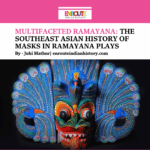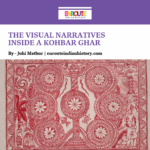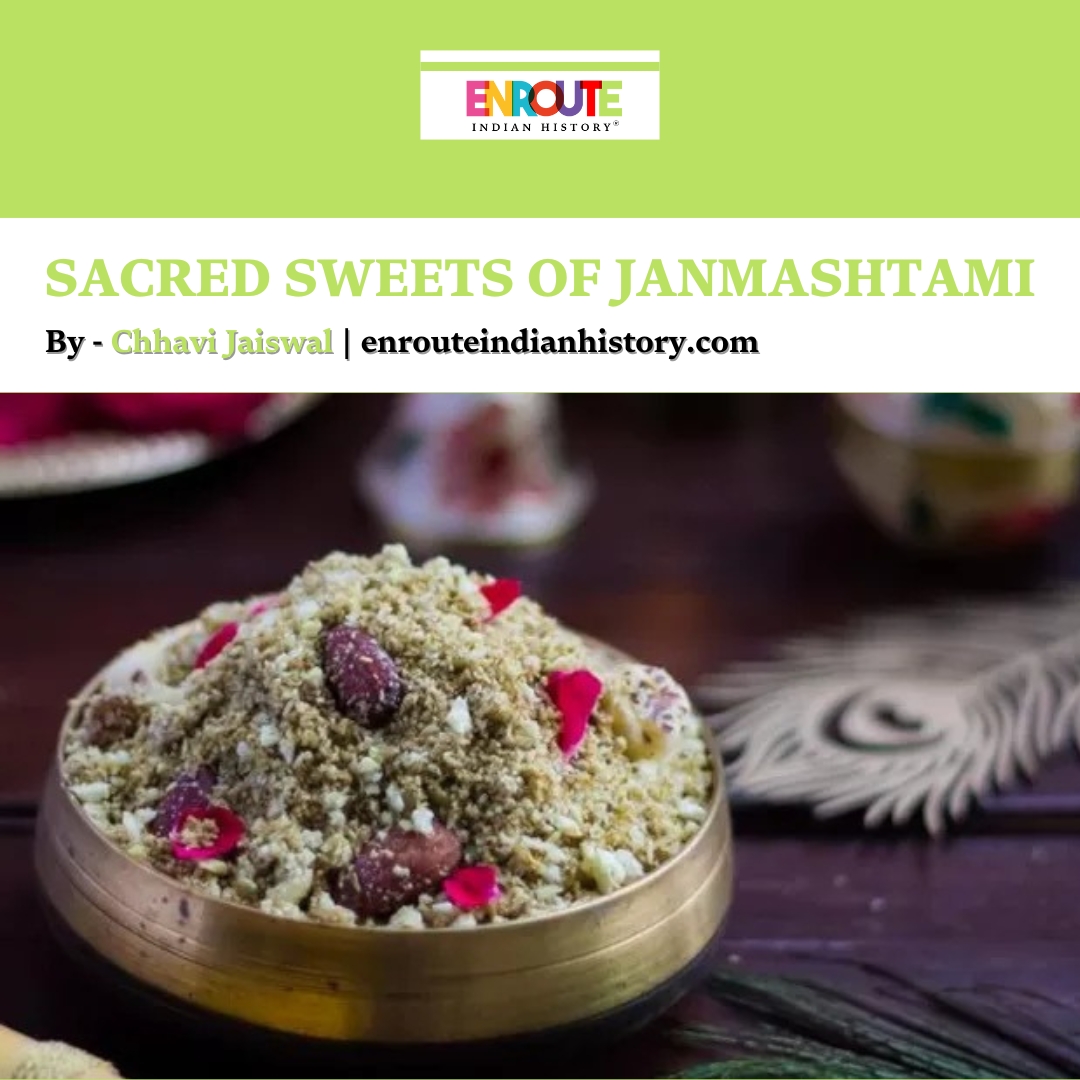
Krishna Janmashtami, the festival celebrating the birth of Lord Krishna, is among the most important Hindu celebrations. Marked by celebrations beginning at midnight, it includes several rituals, including the puja and arti, along with the ritual offerings. The central aspect of the ritual offerings is the chhappan bhoga or the 56-item feast offered to Lord Krishna, which includes several sweet dishes that were considered to be his favourites. Two dishes, namely, panchamrit and panjiri, are considered central to the bhoga. Panchamrit, a sacred mixture of milk, curd, honey, ghee, and sugar, symbolises purity and divine nourishment in Hindu traditions. Panjiri, a nutritious sweet made from roasted whole wheat flour, ghee, sugar, and dry fruits, holds significant importance in northern India and is often associated with strength and vitality, qualities linked to Lord Krishna’s early life. This article explores the religious, cultural, and nutritional aspects of panchamrit and panjiri within the context of Janmashtami, focusing on their preparation, symbolic roles, and how they vary across regions. Through this lens, it will be highlighted how these offerings embody devotion and play an essential role in the ritual practices of the festival.
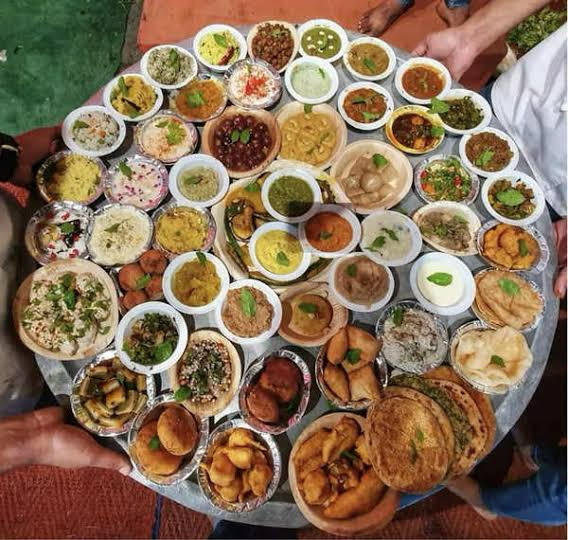
(A traditional chhappan bhoga thaali; Source: Times of India)
Panchamrit, also referred to as charnamrit (the nectar of god’s feet), is a sacred concoction in Hindu tradition, typically prepared as a ritual offering to deities during various religious ceremonies. It is often poured over an idol or offered to the gods while the chanting of mantras, in a ceremonial process known as ‘abhisheka.’ The word Panchamrit is derived from Sanskrit, where ‘pancha’ means five and ‘amrit’ refers to nectar or something immortal. True to its name, Panchamrit consists of five ingredients: milk, curd (yogurt), ghee (clarified butter), honey, and sugar, each of which holds deep symbolic meaning and health significance. In Hindu mythology, one of the earliest references to Panchamrit can be traced back to the Mahabharata, where it is described as a product of the Samudra Manthan, the cosmic churning of the ocean. During this event, both the devtas (gods) and asuras (demons) struggled over the right to consume Panchamrit because it was believed that whoever drank this elixir would attain immortality, granting them eternal life until the end of time. This legendary association with immortality enhances the sanctity and spiritual significance of Panchamrit, as it symbolizes divine nourishment and protection.
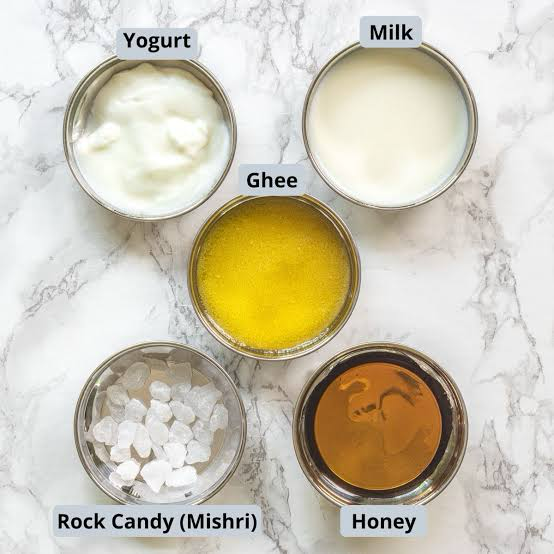
(The five ingredients of Panchamrit; Source: Spice Up the Curry)
The Ayurveda describes all five ingredients of the panchamrit as having distinct qualities. When combined, all of them provide nutrition to the seven bodily tissues, namely plasma, blood, muscle tissues, bone and teeth, bone marrow and nervous tissue and reproductive tissues. Ayurvedic texts also highlight that Panchamrit not only offers numerous spiritual benefits but also supports mental well-being and promotes reproductive health in those who consume it.
In Hindu and Jaina worship, the panchamrit is used for rudra abhishek, after which it is distributed among the devotees as prasad. During Janmashtami, the five ingredients of the panchamrit hold their divine meanings. Milk symbolises purity and reflects Lord Krishna’s fondness for dairy products like milk, butter, and curd. Ghee signifies strength and triumph, while honey embodies devotion and unity, mirroring the collective effort of bees in creating it. Sugar brings sweetness to life, representing bliss, and curd (or dahi) is associated with prosperity. It is prepared by adding sugar to a bowl (preferably a silver one), followed by curd, honey and ghee. Finally, milk is added to the mixture, which is a symbol of nourishment and is considered the most important ingredient of the panchamrit. In the Tamil Nadu region, the preparation varies as the panchamrit or the ‘panchamritam’ consists of plantains, dates, honey, cardamom and ghee and is usually stored as jam after the abhishek. The Janmashtami ritual begins with bathing the idol of Lord Krishna by pouring the panchamrit over it, which is later distributed as prasad. Nowadays, additional ingredients like Tulsi leaves and saffron are also added to enhance the flavour.
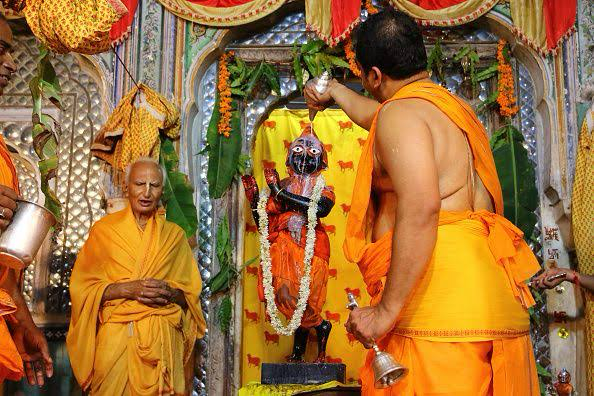
(A panchamrit abhishek ritual; Source: Aaj Tak)
Another ritual offering which forms a part of the bhoga is the panjiri. In northern India, panjiri is prepared by cooking wheat flour in ghee and adding sugar, dry fruits and natural gum. Wheat is a source of carbohydrates, whereas ghee is a healthy fat. The nuts and seeds are loaded with healthy fats, vitamins and minerals and natural gum or gond is a natural resin that strengthens the bones and provides heat to the body. Hence, it is usually prepared in the winter season and eaten as laddoos to ward off ills. Panjiri is also widely regarded as a postnatal food. New mothers are often given this nutritious treat to regain strength, as it is rich in fats, proteins, and carbohydrates. The dish is believed to help heal the body, improve lactation, and boost overall energy levels. It is also fed to children to enhance immunity and promote growth. Panjiri has been associated with Ayurveda since antiquity. It was referred to as Panchajeeraka paka and has been mentioned in texts like Bhava Prakasha Chikitsthana and Yonirogaadhikara.
During Janmashtami, panjiri is prepared with coriander powder as its base, known as dhaniya panjiri. It was considered to be among Lord Krishna’s favourite dishes. The simple, earthy ingredients of the dish reflect the humble upbringing Lord Krishna had during his formative years. All the ingredients are indigenous to the pastoral landscape of Vrindavan and reflective of his early diet as a shepherd. It is prepared by roasting coriander seeds, which are then blended into the form of a powder. Following this, ghee is heated in a separate pan added to which are chopped nuts like almonds, cashew nuts, and raisins. Later, ghee and wheat flour are added to the mixture, followed by the addition of roasted coriander powder along with sugar or jaggery. Dhaniya panjiri is beneficial during Janmashtami as coriander is known for its digestive properties and helps in digestion after a day of fasting when the digestive system is under stress. Additionally, coriander seeds also help cool down the body and maintain blood sugar levels, which makes the dish healthy and refreshing. As prasad, this dish is used to break the fast before taking a meal.
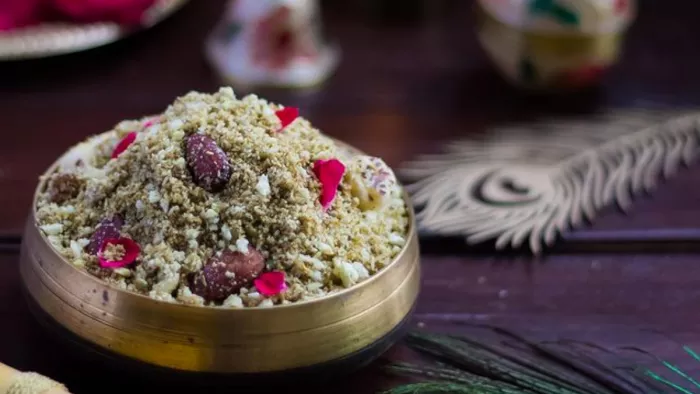
(Dhaniya Panjiri; Source: Jagran)
Both Panchamrit and Panjiri are considered essential to the bhoga served during Janmashtami. They are not only prepared at home but also served in temples during the celebrations. Nowadays, ingredients like makhana or fox nuts and batasha are added to make the dishes more appealing. Despite these adaptations, the essence of Panchamrit and Panjiri remains deeply rooted in tradition, with each household passing down its unique recipe through generations. These legacy dishes have become a cherished part of the Janmashtami celebrations, reflecting the rich culinary heritage of India. The enduring sanctity of these dishes serves as a reminder of the deep cultural and religious values that have shaped their role in Janmashtami over centuries.
Panchamrit and Panjiri are more than just ritual offerings during Krishna Janmashtami; they are integral to the spiritual and cultural fabric of the festival. Panchamrit, with its symbolic ingredients, represents the divine nourishment and blessings that devotees seek from Lord Krishna, while also reflecting the importance of balance in life—purity, strength, devotion, sweetness, and prosperity. Panjiri, deeply rooted in Ayurvedic tradition, symbolizes vitality and sustenance, offering physical strength and spiritual grounding, qualities that are particularly emphasized in Krishna’s early life in the village as a pastoralist.
Moreover, these offerings reflect India’s culinary and spiritual heritage, passed down through generations. They emphasize the connection between food and health, especially in a festive context, where fasting and feasting come together as acts of devotion. Beyond the religious aspect, the preparation and consumption of Panchamrit and Panjiri also signify a sense of community and shared heritage. Whether prepared in homes or temples, these offerings strengthen the bonds between family members and devotees, serving as a reminder of the timeless traditions that continue to unite people in faith and celebration.
References:
- Goyal, Riya, et al. “Panchamrut: A Way Towards Healthier Life An Ayurvedic Overview.” International Journal of Ayurveda and Pharma Research, vol. 11, no. 3, March 2023, pp. 90-94
- Jamooji, Shireen. “ Janmashtami 2024: Festive Panchamrit, The Holy 5 Ingredient Mixture Offered As Prasad.” Times Now, 21 August, 2024 https://www.timesnownews.com/lifestyle/food/recipes/janmashtami-2024-festive-panchamrit-the-holy-5-ingredient-mixture-offered-as-prasad-article-112674384
- “Panchamirtham of Palani Devasthanam.” palani.org, https://palani.org/panchamirtham.htm
- O’ Brien, Charmaine. The Penguine Food Guide to India. Penguin Books, India, 2013, pp. 32.
- Anumol, K. et al. “A Review on Panchajeeraka Paka Indicated in Sutika Kala.” Ayushdhara, vol. 6, no. 6, November-December 2019, pp. 2428-2434
- “Janmashtami 2024: Why Dhaniya Panjiri is prepared for Krishna Janmashtami.” Times of India, 26 August, 2024, https://timesofindia.indiatimes.com/life-style/food-news/dhaniya-panjiri-significance-and-health-benefits-for-janmashtami-2024/articleshow/112804190.cms


